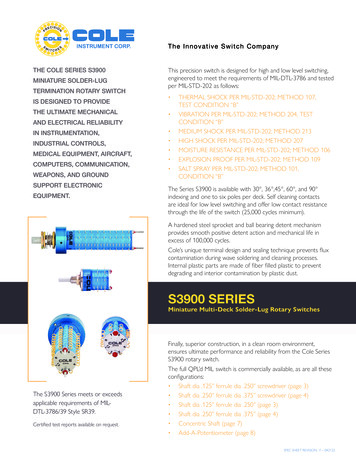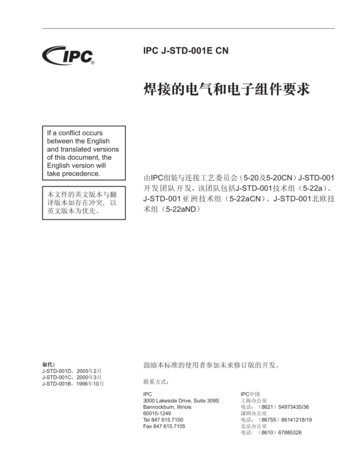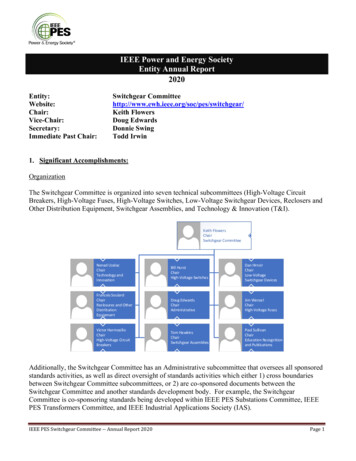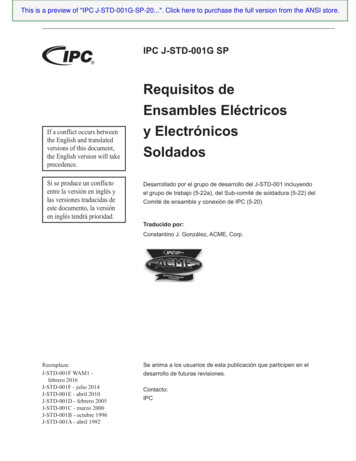
Transcription
Int J STD AIDS OnlineFirst, published on December 31, 2015 as doi:10.1177/0956462415624059GuidelinesUK national guidelines on themanagement of syphilis 2015International Journal of STD & AIDS0(0) 1–26! The Author(s) 2015Reprints and OI: 10.1177/0956462415624059std.sagepub.comM Kingston1, P French2, S Higgins3, O McQuillan1,A Sukthankar1, C Stott1, B McBrien1, C Tipple4, A Turner5,AK Sullivan6, Members of the Syphilis guidelines revision group2015, Keith Radcliffe7, Darren Cousins7, Mark FitzGerald7,Martin Fisher7, Deepa Grover7, Stephen Higgins7,Margaret Kingston7, Michael Rayment7 and Ann Sullivan7AbstractThese guidelines are an update for 2015 of the 2008 UK guidelines for the management of syphilis. The writing grouphave piloted the new BASHH guideline methodology, notably using the GRADE system for assessing evidence and makingrecommendations. We have made significant changes to the recommendations for screening infants born to motherswith positive syphilis serology and to facilitate accurate and timely communication between the teams caring for motherand baby we have developed a birth plan. Procaine penicillin is now an alternative, not preferred treatment, for all stagesof syphilis except neurosyphilis, but the length of treatment for this is shortened. Other changes are summarised at thestart of the guideline.KeywordsSyphilis, diagnosis, treatmentDate received: 5 November 2015; revised: 1st December 2015; accepted: 2 December 2015New in the 2015 guidelinesImportant changes. Procaine penicillin is now an alternative treatmentwhere benzathine penicillin is suitable. This is dueto the pain associated with treatment courses requiring multiple injections and inconvenience and costfor patients and staff. Resistance to macrolide antibiotics limits their utility; they are to be used only when there are no suitable alternatives and with assured follow-up. In asymptomatic disease there is no need for fullroutine examination or chest X-ray (CXR). Amended recommendation to period of sexualabstinence following treatment of early infectioussyphilis. The duration for the recommended treatment ofneurosyphilis is changed to 14 days, consistent withexpert opinion and other guidelines. Amended minimal follow-up recommendations. Some neonates will not need serology followingdelivery. Inclusion of a syphilis birth plan. Clear graded recommendations at the end of eachsection, using the GRADE system.ObjectivesThe main objective is to reduce the number of sexuallytransmitted infections (STIs) and the complications1Manchester Centre for Sexual Health, Manchester, UKMortimer Market Centre, London, UK3North Manchester General Hospital, Manchester, UK4Jefferiss Wing Centre for Sexual Health, Imperial College Health CareNHS Trust, London, UK5The Public Health England/Clinical Virology Laboratory, ManchesterRoyal Infirmary, Manchester, UK6CEG Editor7Clinical Effectiveness Group, British Association for Sexual Health andHIV, Macclesfield, UK2Corresponding author:Margaret Kingston, Manchester Centre for Sexual Health, TheHathersage Centre, 280 Upper Brook Street, Manchester M13 0FH.Email: margaret.kingston@cmft.nhs.ukNICE has accredited the process used by BASHH to produce its European guideline for the managementof syphilis. Accreditation is valid for 5 years from 2011.More information on accreditation can be viewed at www.nice.org.uk/accreditationDownloaded from std.sagepub.com at Imperial College London Library on February 9, 2016
2International Journal of STD & AIDS 0(0)that can arise in people either presenting with signs andsymptoms of an STI or undergoing investigation forpossible infection.Specifically, this guideline offers recommendationson the diagnostic tests, treatment regimens and healthpromotion principles needed for the effective management of syphilis, covering the management of the initialpresentation, as well as how to prevent transmissionand future infection.It is aimed primarily at people aged 16 years or older(although there is a section referring to the management of congenital syphilis [CS] in children) presentingto health-care professionals, working in departmentsoffering level 3 care in STI management within theUnited Kingdom.1 However, the principles of the recommendations should be adopted across all levels(levels 1 and 2 may need to develop, where appropriate,local care pathways).The recommendation of this guideline may not beappropriate for use in all clinical situations. Decisionsto follow these recommendations must be based on theprofessional judgement of the clinician and consideration of individual patient circumstances and availableresources.Search strategyThe previous UK and USA guidelines for the management of syphilis were reviewed.2,3Literature reviews included searching Medline forthe years 2007 to 2014 and the Cochrane library usingthe keywords ‘syphilis’ and ‘syphilis and HIV’ plus additional MeSH headings ‘neurosyphilis’, ‘cardiovascularsyphilis’, ‘latent syphilis’ and ‘syphilis and treatment’.A search on Embase from 2007–2014 was also conducted. Only English language papers were used.MethodsThe guidelines writing group piloted an updated version of the BASHH Framework for GuidelineDevelopment. The previous version last published in2010 is available at: http://www.bashh.org/documents/2926 (last accessed 19 January 2013). Following piloting of this updated framework, incorporating feedbackfrom this and another group of guideline authors, theupdated framework will be published. The majorchange is the adoption of the GRADE system forassessing evidence (http://www.gradeworkinggroup.org/index.htm) [last accessed 19 January 2014].Equality impact assessmentThis was completed using the NICE tool for thisaccessed at: http://www.nice.org.uk/media/4DC/76/Item62 NEquIATTopicSelectionSMTAppB221107.pdfand is an appendix to this document.Stakeholder involvement, piloting andfeedbackThe document was reviewed by the ClinicalEffectiveness Group of BASHH, and their commentsincorporated. The draft guideline was placed on theBASHH website and any comments received aftertwo months were reviewed by the authors and actedon appropriately. The document was also piloted bytarget users and the public panel of BASHH, andtheir feedback considered by the authors.Aetiology, transmission and epidemiology. Syphilis is caused by infection with the spirochetebacterium Treponema pallidum subspecies pallidum.4. It is transmitted by direct contact with an infectiouslesion or by vertical transmission (trans-placentalpassage) during pregnancy.5 Approximately onethird of sexual contacts of infectious syphilis willdevelop the disease (transmission rates of 10–60%are cited).6,7. Site of bacterial entry is typically genital in heterosexual patients, but 32–36% of transmissions amongmen who have sex with men (MSM) may be at extragenital (anal, rectal, oral) sites through oral-anal orgenital-anal contact.8 In one study, oral sexaccounted for 13.7% of syphilis transmissions, particularly in MSM.9 Injecting drug use (sharing needles) and blood transfusion (rare as routinescreening is performed in the UK and treponemalsurvival beyond 24–48 h at 4 C is unlikely) are alsopotential routes of transmission.10,11. T. pallidum readily crosses the placenta and verticaltransmission can occur at any stage of pregnancy.The risk of transmission varies with syphilis stageand is greatest in early disease.12,13 Accordingly,transmission was associated with rapid plasmareagin (RPR) titres 8 (RR 18.1, p 0.001) in onecohort study.14. Syphilis predominates among white MSM aged25–34, many of whom (40%) are HIV-1 co-infected.In 2014, there were 4317 cases of infectious syphilis,of which 3477 cases were in MSM. Compared with2013, this represents a 46% rise among MSM and a33% rise overall.15 There were 263 cases in women in2014. Rates of CS are correspondingly low (0.0025/1000 live births in 2011) and predominantly amongchaotic and socio-economically deprived womenpresenting to antenatal services in the thirdtrimester.15,16Downloaded from std.sagepub.com at Imperial College London Library on February 9, 2016
Kingston et al.3Classification and clinical features. Syphilis is a multi-stage, multi-system disease, whichis broadly defined as congenital or acquired.(headache, neck stiffness, photophobia, nausea)and cranial nerve palsies including eighth nervepalsy with resultant hearing loss and possible tinnitus.29 Eye involvement may result in uveitis(most commonly posterior), optic neuropathy, interstitial keratitis and retinal involvement.30Acquired (adult) diseaseEarly diseaseLatent disease. Following contact, T. pallidum invade through themucosal surface or abraded skin and divide at thepoint of entry to produce the chancre of primary disease. This incubation period is typically 21 days(range 9–90), but is dependent on infectious dose –larger doses resulting in ulcers more quickly.7,17Primary syphilis is characterised by a single papuleand moderate regional lymphadenopathy. Thepapule subsequently ulcerates to produce a chancre,which is classically anogenital (penile, labial, cervicalor peri-anal), single, painless and indurated with aclean base discharging clear serum but not pus.However, chancres may also be multiple, painful,purulent, destructive, extra-genital (most frequentlyoral) and may cause the syphilitic balanitis ofFollmann.18,19 When present at extra-genital sitesand painless, they may pass unnoticed. In the contextof HIV-1 co-infection, they may be multiple, deeperand persist into the secondary stage of disease.20Early after infection, the bacteria disseminate widelyvia blood and lymphatics. They are subject to localimmune clearance and ulcers resolve over 3–8 weeks. Untreated, 25% of patients will develop signs of secondary syphilis approximately 4–10 weeks after theappearance of the initial chancre.21,22 Secondarysyphilis is multi-system and typically occurs threemonths after infection.5 It often presents with awidespread mucocutaneous rash and generalisedlymphadenopathy. The rash may be maculo-papular(50–70%), papular (12%) or macular (10%) and itmay, but does not usually, itch.21,23,24 It can affectthe palms and soles (11–70%) and hair follicles,resulting in alopecia. Two more important mucocutaneous signs are mucous patches (buccal, lingualand genital) and highly infectious condylomata lataaffecting warm, moist areas (mostly the perineumand anus).8,23 HIV-1 infection does not appear toimpact on the mucocutaneous manifestations of secondary syphilis.25 Secondary syphilis may result inhepatitis; glomerulonephritis (mediated by antibodytreponeme complex deposition) and splenomegaly.26–28 A small proportion of patients (1–2%) willdevelop neurological complications during secondary syphilis.21 These are typically acute meningitis. Secondary syphilis will resolve spontaneously in3–12 weeks and the disease enters an asymptomaticlatent stage.21 This is defined as early within twoyears, and late thereafter (ending with the development of tertiary disease). The distinction betweenearly and late latent disease is somewhat arbitrary,but important as approximately 25% of patients willdevelop a recurrence of secondary disease during theearly latent stage.22Late (tertiary) disease. Late disease occurs in approximately one-third ofuntreated patients around 20–40 years after initialinfection. It is divided into gummatous disease(15% of patients); cardiovascular (10%) and lateneurological complications (7%).22 The clinical manifestations of late syphilis are highly variable and arerarely seen due to the use of treponemocidal antibiotics for other indications. The clinical features ofsymptomatic late syphilis are summarised in Table 1.Gummatous disease. In the Oslo study, 15% of patients developed gummatous disease.22 These granulomatous lesions withcentral necrosis can occur within two years oflatency, but are typically seen after an average15 years.5 They can occur anywhere, but mostoften affect skin and bones. They rapidly resolveon administration of therapy.Cardiovascular disease. Cardiovascular syphilis typically occurs 15–30 yearsafter infection. It only becomes symptomatic orcomplicated in 10% of patients.22 The ascendingaorta is the predominant site of damage resultingin dilatations and aortic valve regurgitation.Rarely, the coronary ostia may become involvedand saccular aneurysms may develop.31Downloaded from std.sagepub.com at Imperial College London Library on February 9, 2016
4International Journal of STD & AIDS 0(0)Table 1. Clinical features of symptomatic late syphilis.NeurosyphilisAsymptomaticTiming after infectionSigns and symptomsEarly/lateAbnormal CSF with no signs/symptoms; this is of uncertain significance given that CSF abnormalities have been found in up to30% of primary and secondary syphilis yet this does notbecome clinically significant in the majority of patients.Focal arteritis inducing infarction/meningeal inflammation; signsdependent on site of vascular insult. Occasional prodrome;headache, emotional lability, insomnia.Cortical neuronal loss; gradual decline in memory and cognitivefunctions, emotional lability, personality change, psychosis anddementia. Seizures and hemiparesis are late complications.Inflammation of spinal dorsal column/nerve roots; lightning pains,areflexia, paraesthesia, sensory ataxia, Charcot’s joints, malperforans, optic atrophy, pupillary changes (e.g. ArgyllRobertson pupil).Meningovascular2–7 yearsParenchymous General paresis10–20 years Tabes dorsalis15–25 yearsCardiovascular10–30 yearsAortitis (usually ascending aorta); asymptomatic, substernal pain,aortic regurgitation, heart failure, coronary ostial stenosis,angina, aneurysm.Gummatous1–46 years(average 15)Inflammatory granulomatous destructive lesions; can occur in anyorgan but most commonly affect bone and skin.CSF: cerebrospinal fluid. Pupillary abnormalities common (Argyll-Robertson). Dorsal column loss (absent reflexes, joint positionand vibration sense)Neurological diseaseMeningovascular syphilis. Typically, 5–10 years after infection (may be earlier).Not typically considered to be tertiary disease. Infectious arteritis which may result in ischaemicstroke (middle cerebral artery territory most commonly affected). Prodrome may occur in the weeks/months prior tostroke including headache, emotional lability andinsomniaCongenital syphilis. CS is divided into early (diagnosed in the first twoyears of life) and late (presenting after two years).The presence of signs at the time of delivery isdependent on the duration of maternal infectionand the timing of treatment. Around two-thirds ofinfants with CS will be asymptomatic at birth butmost will develop signs by five weeks.32,33General paresis. Progressive dementing illness 10–25 years after infection secondary to cortical neuronal loss. Initial forgetfulness and personality change whichdevelop into severe dementia. Seizures and hemiparesis may occur (late)Tabes dorsalis. 15–25 years after infection (longest of neurologicalcomplications). Characterised by sensory ataxia and lighting painsEarly CS (within two years). Common manifestations (40–60% will have one)include: rash, haemorrhagic rhinitis (bloody snuffles), generalised lymphadenopathy, hepatosplenomegaly and skeletal abnormalities33. Other signs include: condylomata lata, vesiculobullous lesions, osteochondritis, periostitis, pseudoparalysis, mucous patches, perioral fissures, nonimmune hydrops, glomerulonephritis, bocytopeniaDownloaded from std.sagepub.com at Imperial College London Library on February 9, 2016
Kingston et al.5Late congenital syphilisExamination. Signs develop as a result of chronic and persistentinflammation resembling gummatous disease inadults. Stigmata of congenital infection includes:interstitial keratitis; Clutton’s joints; Hutchinson’sincisors; mulberry molars (maldevelopment of cuspsof first molars); high palatal arch; rhagades (peri-oralfissures); sensineural deafness; frontal bossing; shortmaxilla; protuberance of mandible; saddlenosedeformity; sterno-clavicular thickening; paroxysmalcold haemoglobinuria; neurological involvement(intellectual disability, cranial nerve palsies).33,34. Early disease (primary or secondary) to include thefollowing, when indicated:. Genital examination. Skin examination including eyes, mouth, scalp,palms and soles. Neurological examination if neurological symptoms elicited. Symptomatic late disease (including suspected latecongenital disease); clinical examination should beundertaken as indicated, with attention to:. Skin. Musculoskeletal system (congenital). Cardiovascular system (for signs of aorticregurgitation). Nervous system (general paresis: dysarthria,hypotonia, intention tremor, and reflex abnormalities; Tabes dorsalis: pupil abnormalities,impaired reflexes, impaired vibration andjoint position sense, sensory ataxia and opticatrophy)Clinical diagnosisHistory. A full and accurate history is important to identifypotential complications of symptomatic infection(both early and late) and to distinguish betweenlate latent, previously treated and non-venerealT. pallidum infection (yaws, pinta, bejel), whichmay have identical serological results. Full sexual history:. For primary syphilis – to include all sexual partners in the last three months. Early secondary and early latent syphilis – allpartners in the last two years. For late syphilis – according to history and previous treponemal serology, lifetime partners andpossibly children. Directly question for symptoms of syphilis. Fully explore previous syphilis diagnoses:. Year and place of diagnosis. Treatment received (drug, route, duration). Serological results (contact treating centre ifnecessary/possible). Previous syphilis testing (with consideration of thescreening tests used at the time):. Antenatal screening. Blood donation. Sexual health screening. Potential for previous infection with non-venerealT. pallidum infection:. Childhood skin infections (yaws). Previously resident in an endemic area/country. Full obstetric history (where appropriate):. Adverse pregnancy outcomes (which may be dueto syphilis). Identify live births and children who may havelate congenital diseaseLaboratory diagnosisDemonstration of T. pallidum from lesions orinfected lymph nodes. Dark ground microscopy:35. Should be performed by experienced observers. Is less reliable in examining rectal and non-penilegenital lesions and not suitable for examining orallesions due to the presence of commensaltreponemes. Polymerase chain reaction (PCR):36–38. Can be used on oral or other lesions where commensal treponemes may also be present. Available at reference laboratories. In certain circumstances, PCR may be helpful indiagnosis by demonstrating T. pallidum in tissuesamples, vitreous fluid and cerebrospinal fluid(CSF)39–42Recommendations. Where appropriate expertise and equipment areavailable, perform dark ground microscopy on possible chancres: 2A. T. pallidum testing by PCR is appropriate onlesions where the organism may be expected to belocated: 1A.Downloaded from std.sagepub.com at Imperial College London Library on February 9, 2016
6International Journal of STD & AIDS 0(0)Serological test for syphilis. Treponemal antibody tests cannot differentiate syphilis (caused by infection with T. pallidum subspeciespallidum) from the endemic treponematoses, yaws(caused by infection with T. pallidum subspecies pertenue), bejel (or endemic syphilis, caused by infectionwith T. pallidum subspecies endemicum) and pinta(caused by infection with T. pallidum subspecies carateum). Positive treponemal serology in patients froma country with endemic treponemal infection shouldtherefore be investigated and treated for syphilis as aprecautionary measure, unless they have been adequately treated for syphilis previously.43. Treponemal antibody tests can be classified into:. Non-specific (cardiolipin, lipoidal, reagin or nontreponemal) tests: Venereal Diseases ResearchLaboratory (VDRL) carbon antigen test/RPR test. Specific (treponemal) tests: treponemal enzymeimmunoassay (EIA) or treponemal chemiluminescent assay (CLIA); Treponema pallidum haemagglutinationassay(TPHA);Treponemapallidum particle agglutination assay (TPPA),fluorescent treponemal antibody absorption test(FTA-abs), Treponema pallidum immunoblot.Most of these tests are now based on recombinanttreponemal antigens and detect treponemalIgG and IgM antibody. T. pallidum-specific IgM antibody tests: anti-treponemal IgM EIA and immunoblot.Primary screening tests. Treponemal EIA/CLIA (preferably a test thatdetects both IgG and IgM) or TPPA, which is preferred to TPHA. Request an anti-treponemal IgM test if primarysyphilis is suspected. The clinical utility of the IgMtest is limited by its suboptimal sensitivity and itshould not be used to stage disease or decide theduration of treatment required.43. Rapid treponemal tests might be useful is some outreach settings, provided positive results are confirmed by laboratory tests.43Confirmatory tests. Positive screening tests should be confirmed with adifferent treponemal test. An IgG immunoblot is recommended as a supplementary confirmatory test when the standard confirmatory test does not confirm the positivescreening test result. The FTA-abs is notrecommended as a standard confirmatory test,although it may have a role in specialist laboratories. A second specimen should always be tested to confirm positive results, and on the day that treatmentis commenced so the peak RPR/VDRL isdocumented.Tests for assessing serological activity of syphilis. A quantitative RPR/VDRL should be performedwhen treponemal tests indicate syphilis as thishelps stage the infection and indicates the need fortreatment in some cases, for example, where thepatient has been previously treated and may havebeen re-infected.43. An initial RPR/VDRL titre of 16 usually indicatesactive disease and the need for treatment, althoughserology must be interpreted in the light of the treatment history and clinical findings.44. A RPR/VDRL titre of 16 or less does not excludeactive infection, particularly in a patient with clinicalsigns suggestive of syphilis or where adequate treatment of syphilis is not documented. A negative anti-treponemal IgM test does notexclude active infection, particularly in late disease.Tests for monitoring the effect of treatment. A quantitative RPR/VDRL test is recommendedfor monitoring the serological response to treatment and should be performed on a specimentaken on the day that treatment is started as thisprovides an accurate baseline for monitoringresponse to treatment.Repeat screening is recommended. Six and 12 weeks after a single ‘high risk’ exposure(unprotected oral, anal or vaginal intercourse withhomosexual man, multiple partners, anonymoussex in saunas and other venues, commercial sexworker or sex partner linked with a countrywhere the prevalence of syphilis is known to behigh). In individuals at ongoing risk due to frequent ‘highrisk’ exposures as defined above, screening as part ofroutine sexual health check-ups for all STIs including HIV and others is recommended, usually everythree months and informed by sexual history. Two weeks after presentation in those with dark fieldor PCR negative ulcerative lesions that could be dueto syphilis.Downloaded from std.sagepub.com at Imperial College London Library on February 9, 2016
Kingston et al.7False-negative syphilis serology. Treponemal screening tests are negative before achancre develops and may be for up to two weeksafterwards. A false-negative RPR/VDRL test may occur in secondary or early latent syphilis due to the prozonephenomenon when testing undiluted serum, in suchcases negative tests on undiluted sera should berepeated on diluted sera.45 This may be more likelyto occur in HIV-infected individuals.46. The RPR/VDRL and IgM may be negative in latesyphilis.42False-positive syphilis serology. Occasional false-positive results may occur with anyof the serological tests for syphilis. In general, false-positive reactivity is more likely inautoimmune disease, older age and injecting drug use. In the absence of symptoms of syphilis, a history ofsyphilis or a concomitant positive anti-treponemalIgM; transient or persistent reactivity in a singletreponemal antigen test should be considered to bea false-positive result.Recommendations. An EIA/CLIA, preferably detecting both IgM andIgG IS the screening test of choice: 1B. Positive screening tests should be confirmed with a different treponemal test (not the FTA-abs) and a secondspecimen for confirmatory testing obtained: 1B. A quantitative RPR or VDRL should be performedwhen screening tests are positive: 1A. Repeat negative serological tests for syphilis (STS):. At six and 12 weeks after an isolated episodewhich is high risk for exposure to syphilis,. At two weeks after possible chancres that aredark-ground and/or PCR negative are observed:1B.Evaluation of neurological, cardiovascularor ophthalmic involvement. CXR in late latent syphilis is not recommended as aroutine investigation.47 Patients with syphilis whohave symptoms or signs of cardiovascular involvement should have a full cardiovascular assessment. Patients should have a thorough neurological examination if they have symptoms suggestive of neurological involvement.48. Computed tomography (CT) or magnetic resonanceimaging (MRI) imaging of the brain should be considered if symptoms or signs are present, with one ofthese being performed and reviewed prior to lumbarpuncture. Routine CSF examination of patients with latentsyphilis is not recommended.49,50. Serum RPR/VDRL titre may offer some guidance asto whether or not a lumbar puncture should beundertaken. In a retrospective study of patientswith latent syphilis, a negative VDRL in the peripheral blood was found to have 100% sensitivity inexcluding CSF abnormalities compatible with thediagnosis of neurosyphilis,51 whereas a serum RPRof 1:32 has been demonstrated to predict CSFabnormalities compatible with neurosyphilis.52. Indications for CSF examination in late syphilisinfection include: where there is clinical suspicionof neurosyphilis or treatment failure.Interpretation of CSF serology. CSF serology should be interpreted in conjunctionwith the clinical presentation of the patient. The testswe have are better at excluding neurosyphilis thanhelping to diagnose it. However, no CSF test resultcan definitively exclude a diagnosis of neurosyphilis.53 Definitive diagnosis of neurosyphilis is histological, usually an impossibility in practice. CSFtests can only support clinical diagnosis. In order for these tests to be interpreted accurately,it is vital that the CSF is not macroscopically contaminated with blood.54 Positive syphilis tests onCSF should be interpreted in conjunction with biochemical examination of the CSF as well as clinicalsigns and symptoms. The majority of individuals who have symptomaticneurosyphilis have a raised white cell count( 5 cells/mm) in the CSF, though in cases of parenchymous neurosyphilis this may not be the case.43. The overall sensitivity of the CSF VDRL/RPR isaffected by the stage of syphilis. The RPR is lesssensitive than the VDRL, with a range of 10% forasymptomatic cases to 90% for symptomatic cases.55. In the CSF, the RPR is less sensitive than theVDRL. Both tests are relatively insensitive in CSFso false-negatives are common.56. A negative treponemal test on CSF makes a diagnosis of neurosyphilis unlikely but does not exclude thediagnosis.53 A positive test is highly sensitive forneurosyphilis but lacks specificity because reactivitymay be caused by transudation of immunoglobulinsfrom the serum into the CSF57 or by leakageDownloaded from std.sagepub.com at Imperial College London Library on February 9, 2016
8International Journal of STD & AIDS 0(0)Table 2. The CSF criteria supporting a diagnosis of neurosyphilis (58, 136).CSFparametersIn HIV-negativeindividualsIn HIV-positiveindividualsWBC 5 mL 20 mL OR6–20 mL (on ART/plasma HIV VLundetectable, orblood CD4 200) 0.45 g/lþ 1:320ProteinRPR/VDRLTPPA 0.45 g/lþ 1:320ART: antiretroviral therapy; TPPA: Treponema pallidum particle agglutination assay; VDRL: Venereal Diseases Research Laboratory; RPR: rapidplasma reagin; CSF: cerebrospinal fluid.through a damaged blood–brain barrier resultingfrom conditions other than syphilis. The suboptimal sensitivity and specificity of T. pallidum PCR on CSF means that it is currently considered unhelpful in this circumstance.43. In HIV-positive patients who are not co-infected withsyphilis, CSF WBC 5 is associated with: CD4 200or HIV viral load (VL) 40 or not taking antiretroviral therapy (ART). Thus, a CSF pleocytosis inpatients on ART, or with plasma HIV VL 40 orperipheral blood CD4 200 are more likely to bedue to neurosyphilis rather than HIV infection.58. The CSF criteria supporting a diagnosis of neurosyphilis are summarised in Table 2.Diagnosis of cardiovascular syphilis. This diagnosis is made by the presence of thetypical clinical features of cardiovascular syphilis(see Table 1) combined with positive syphilis serology. Patients with suspected cardiovascular syphilis need assessment by a cardiologist.Diagnosis of gummata. Diagnosis of syphilitic gummata is usually made onclinical grounds; typical nodules/plaques or destructive lesions in individuals with positive syphilis serology. Histological examination of a lesion maysuggest this diagnosis and T. pallidum may be identified within the nodules by PCR.Recommendation. Those with possible gummatous, neurological orcardiovascular symptoms or signs requireexamination and further evaluation by appropriatespecialists: 1C.Diagnosis of CS. Direct demonstration of T. pallidum by darkground microscopy and/or PCR of exudates fromsuspicious lesions, or body fluids, e.g. nasaldischarge.59. Serological tests should be performed
Date received: 5 November 2015; revised: 1st December 2015; accepted: 2 December 2015 New in the 2015 guidelines Important changes. Procaine penicillin is now an alternative treatment where benzathine penicillin is suitable. This is due to the pain associated with treatment courses requir-ing multiple injections and inconvenience and cost











